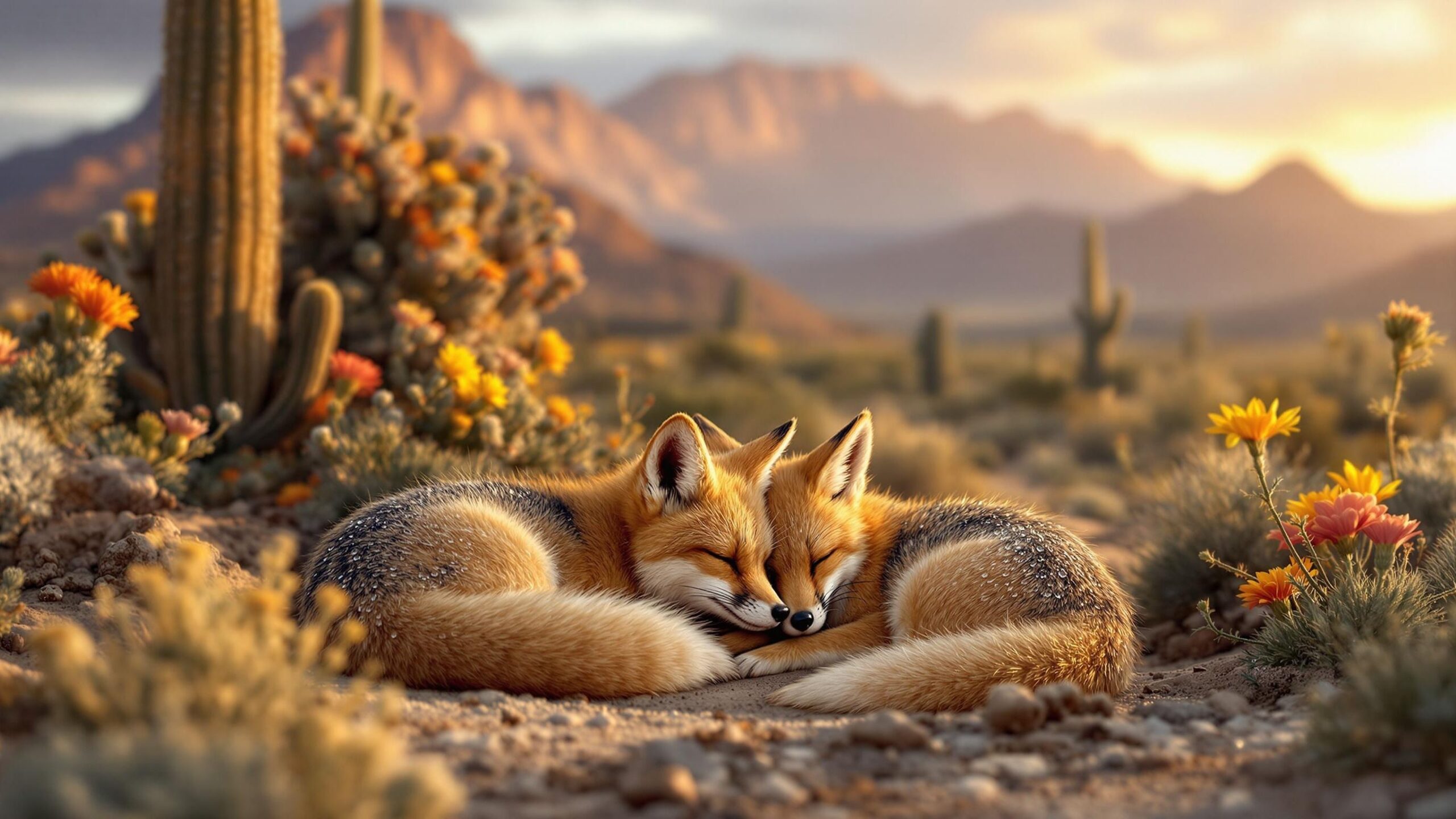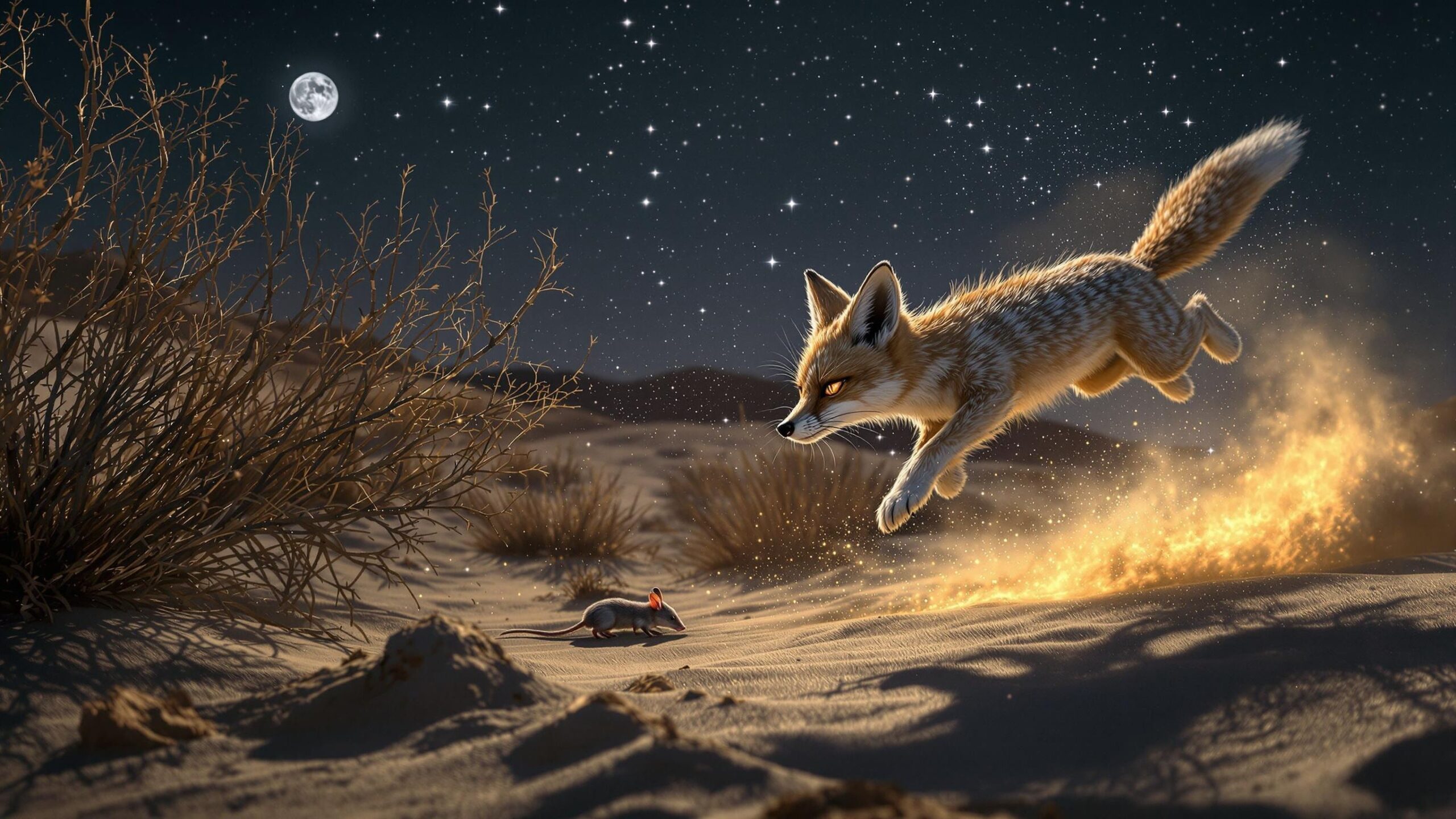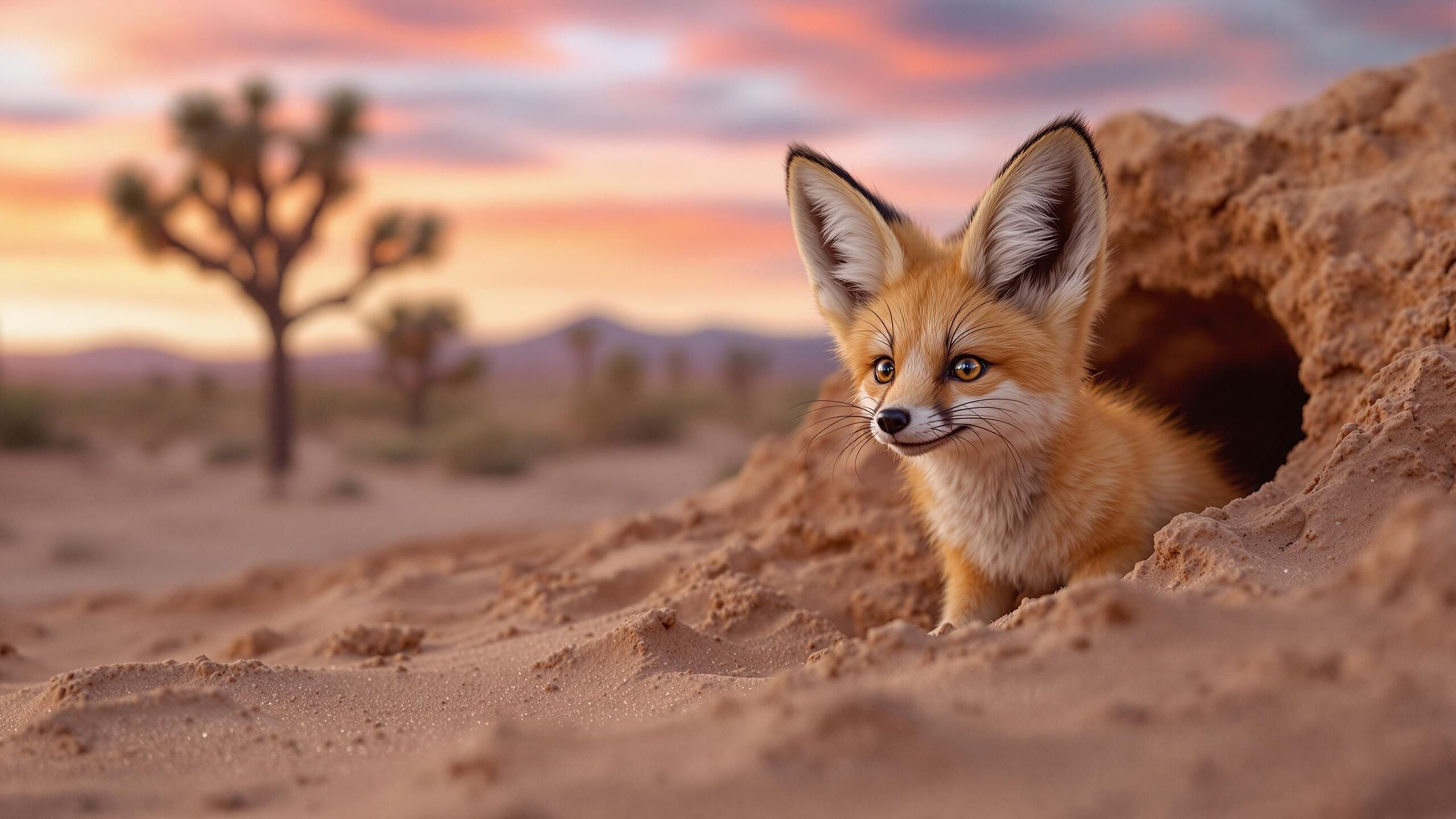The Kit Fox: Desert Phantom with Giant Ears
As twilight falls across North America’s deserts, a small, nimble shadow darts across the sands. Low to the ground, with oversized ears and a ghost-like gait, the Kit Fox emerges from its burrow into the cool night air. Known scientifically as Vulpes macrotis, this diminutive fox is one of nature’s most skilled desert survivors. Adapted to endure extremes of heat, scarcity, and predator threat, the Kit Fox has earned its place as one of the most intriguing and underappreciated species of the American Southwest.
Though not as widely recognized as its cousin, the Red Fox, the Kit Fox offers a masterclass in desert living. From its physiology and hunting skills to its unique social behavior and ecological role, the Kit Fox is a small wonder of evolutionary design. Let’s explore the life of Vulpes macrotis—the fox built for the dunes.
Meet Vulpes macrotis: The Big-Eared Fox
The scientific name of the Kit Fox provides an immediate clue to one of its defining features. “Macrotis” comes from the Greek for “large ear,” and indeed, this is a fox whose ears are often longer than its head. These satellite-dish-like ears serve a dual purpose. First, they are crucial tools for detecting the faint sounds of prey moving beneath the sand or among dry vegetation. Second, they function as built-in air conditioners, helping to regulate body temperature by releasing excess heat.
Kit Foxes are among the smallest wild canids in North America. They weigh between 3 and 6 pounds and measure just 18 to 21 inches in body length, with tails that add another 10 to 14 inches. Their fur is a mix of buff, gray, and pale yellow, allowing them to blend seamlessly into sandy, arid surroundings. Unlike some foxes, the Kit Fox has a slender frame and delicate bone structure, giving it the lithe appearance of a creature built for speed and stealth.
Desert Habitat: Thriving Where Others Struggle
The Kit Fox is native to arid and semi-arid regions across the southwestern United States and northern Mexico. Its range includes parts of California, Arizona, Nevada, Utah, New Mexico, and Texas. It’s particularly associated with the Mojave, Sonoran, and Chihuahuan deserts—regions where daytime temperatures soar, vegetation is sparse, and water is scarce.
These foxes prefer habitats like desert scrub, open plains, dry washes, and low-lying dunes. Unlike Red Foxes or Gray Foxes, which may inhabit forests or suburban edges, the Kit Fox is a specialist of the barren and open. Here, its agility, light coloration, and low profile make it nearly invisible during movement and at rest. One of the Kit Fox’s greatest adaptations to the desert is its ability to go long periods without direct water. Instead, it derives moisture from the food it consumes. By staying hidden during the heat of the day and emerging at dusk, it avoids the worst of the desert’s sun while remaining a highly effective nocturnal predator.
Den Life: Subterranean Safe Havens
Kit Foxes are highly reliant on their dens, more so than many other fox species. A single Kit Fox may use several different dens over the course of a year, rotating between them to avoid predators and parasites. These burrows can be dug by the fox itself, although they often inherit and renovate dens originally excavated by badgers, ground squirrels, or kangaroo rats.
Dens are used year-round, not just during the breeding season. They serve as places to rest during the day, shelter from inclement weather, and raise pups. A typical den may have multiple entrances and chambers, allowing for escape routes and additional storage space. In areas with softer soil and abundant prey, a single territory may contain several active or abandoned dens, which the fox cycles through regularly. Denning behavior is also a crucial strategy for surviving the intense summer heat. In the cool subterranean environment, Kit Foxes can conserve energy and remain safe from predators like coyotes, raptors, and bobcats.

Hunting Strategy: A Carnivore with a Taste for Variety
Despite its small size, the Kit Fox is a competent and resourceful hunter. It primarily feeds on small mammals such as kangaroo rats, mice, ground squirrels, rabbits, and voles. Insects like grasshoppers, beetles, and crickets form a major part of the diet, particularly in the warmer months. Birds, lizards, snakes, and carrion also contribute to its opportunistic menu. Kit Foxes use their large ears to detect the movement of prey even underground. Once a target is located, they rely on swift bursts of speed, stealthy approach tactics, and sharp reflexes to capture it. Their light body weight allows them to walk on top of loose sand or gravel without making noise.
Interestingly, in times of scarcity, Kit Foxes may expand their dietary habits to include fruits, berries, or seeds, making them technically omnivorous. This adaptability helps them survive during droughts or in environments where prey populations fluctuate seasonally. Some Kit Foxes cache food for later, burying leftovers near their den or in shallow holes. This behavior helps them maintain access to resources during lean periods.
Social Behavior and Family Dynamics
The Kit Fox is generally monogamous, forming lifelong pair bonds with a mate. Mating typically occurs between December and February. After a gestation period of about 50 to 55 days, the female gives birth to a litter of two to seven pups, usually in late February or March. The family unit remains together at the den for several months. Both parents participate in rearing the pups. While the mother nurses and cares for the young inside the den, the father takes on the responsibility of hunting and bringing food back to the family. As the pups grow older, both parents teach them hunting techniques through play and guided foraging.
The young begin to emerge from the den around four weeks of age and start hunting independently at about three months. By late summer or early fall, they typically disperse to establish territories of their own, although some females may remain near their birth site if conditions allow. Communication between Kit Foxes is subtle. They emit high-pitched barks, yips, and whines but rely more heavily on scent marking and body language to convey information. Territories are marked with urine and glandular secretions that act as chemical messages to others of the same species.
Survival in the Shadows: Avoiding Predators
The desert is a dangerous place, and Kit Foxes face several natural predators. Coyotes are the most significant threat, capable of easily overpowering a Kit Fox. Golden eagles, great horned owls, and bobcats are also known to prey upon them, particularly juveniles. To avoid detection, Kit Foxes rely on a combination of behaviors. They are strictly nocturnal, rarely active during daylight hours unless forced by circumstance. Their fur blends into the desert surroundings, and their gait is low and fluid, minimizing noise and movement. When threatened, they may retreat to a nearby den, often one with multiple exits to allow for a quick escape.
While Kit Foxes are small, their speed is impressive. When startled, they can reach speeds of up to 25 to 30 miles per hour over short distances—enough to outpace many ground predators for brief sprints. Their small size also helps them exploit spaces that larger predators can’t reach, including narrow crevices, rock formations, and abandoned burrows too tight for a coyote or bobcat.
Ecosystem Role: Unsung Hero of the Desert
Despite their elusive nature, Kit Foxes play a vital ecological role in the desert. As predators of small mammals and insects, they help control populations that might otherwise reach unsustainable levels. This, in turn, benefits the health of desert vegetation, which can suffer from overgrazing by rodents. Kit Foxes also indirectly contribute to seed dispersal when they consume fruit or berries. Though not their primary food source, these items occasionally appear in their diet and pass through their digestive systems, helping to regenerate desert flora.
Their dens are important shelters for other animals as well. Abandoned Kit Fox burrows may be reused by reptiles, amphibians, small mammals, or insects. In this way, Kit Foxes help create and maintain habitat structures that benefit a wider community of desert life. Biologists regard Kit Foxes as indicators of ecological health. When they are present and breeding successfully, it suggests that the local ecosystem still supports balanced predator-prey dynamics, sufficient prey, and intact habitat.

Conservation: Challenges and Comebacks
Though the Kit Fox is not currently endangered across its full range, certain populations face significant conservation challenges. The most notable is the San Joaquin Kit Fox (Vulpes macrotis mutica), a subspecies native to California’s Central Valley. Listed as endangered under the U.S. Endangered Species Act, the San Joaquin Kit Fox has lost much of its natural habitat to agriculture, oil development, and urban sprawl. Habitat fragmentation remains a key threat for all Kit Fox populations. As deserts are developed or divided by roads, Kit Foxes face greater risks of vehicle strikes, loss of prey base, and increased contact with domestic animals carrying disease. Diseases such as sarcoptic mange, rabies, and canine distemper can spread quickly through small, isolated populations. In regions where coyotes have expanded their range due to human changes in the landscape, competition and predation on Kit Foxes increase significantly.
Conservation efforts include habitat restoration, creation of wildlife corridors, disease monitoring, and education campaigns to reduce negative interactions with humans. Some areas have successfully reintroduced Kit Foxes or bolstered existing populations through controlled breeding and release programs. Despite these pressures, the Kit Fox’s general adaptability and low-impact lifestyle make it a good candidate for long-term survival, provided it receives adequate habitat protection and monitoring.
Coexistence with Humans
Unlike many wild animals, Kit Foxes are relatively tolerant of human presence—as long as they’re not disturbed. In rural communities and the outskirts of desert towns, they may forage near outbuildings or den under abandoned structures. However, they are shy and almost never pose a threat to pets or livestock. Encounters are rare due to their nocturnal habits, but motion-sensitive cameras and nighttime fieldwork have revealed Kit Foxes living surprisingly close to human developments. As long as roads, fences, or large predators don’t block access, Kit Foxes can persist even in moderately modified environments.
Educating the public about the Kit Fox’s ecological value helps reduce fear and misinformation. Proper trash disposal, responsible pet ownership, and wildlife-friendly fencing can go a long way in supporting coexistence. In some places, Kit Foxes have become unexpected ambassadors for conservation—charming locals and visitors alike with their expressive faces, bushy tails, and shy demeanor.
Nature’s Subtle Masterpiece
The Kit Fox is not a headline-stealing predator. It doesn’t howl at the moon or prowl in packs. Instead, it slips through the desert like a whisper, weaving through sagebrush and shadows with grace and purpose. Its strength lies not in size or ferocity, but in finely tuned efficiency. Every aspect of the Kit Fox—its ears, its eyes, its light step and quiet den—tells the story of a species shaped by survival. It reminds us that the desert, often perceived as barren, is filled with creatures of depth, complexity, and quiet brilliance.
Protecting the Kit Fox means protecting the broader desert ecosystem it calls home. It means preserving not just a species, but a way of life—one that has thrived on balance, subtlety, and resilience for thousands of years. And while you may never spot one on your desert hike, if you pause in the cool silence of a moonlit canyon, you might just catch the rustle of paws in the sand. The Kit Fox is there, watching, listening, and carrying forward the legacy of one of nature’s most finely crafted desert dwellers.

